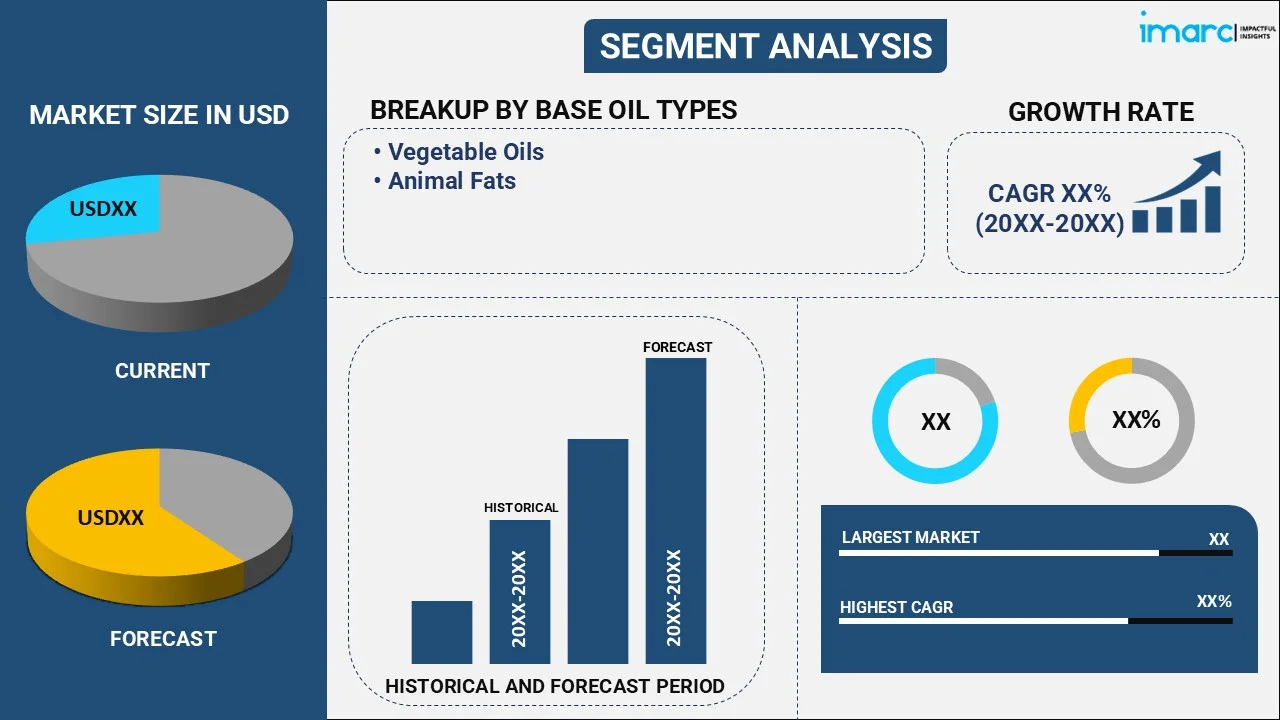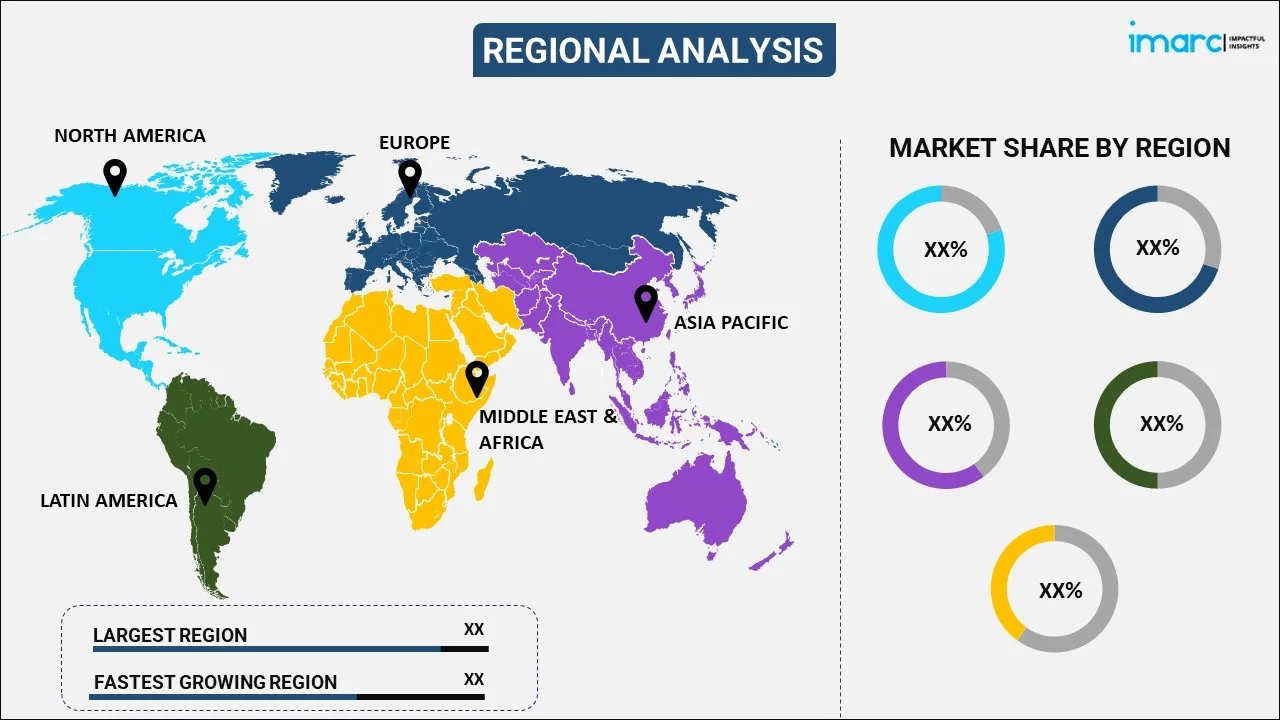
Bio-Lubricants Market Report by Base Oil Type (Vegetable Oils, Animal Fats), Application (Hydraulic Fluids, Metalworking Fluids, Chainsaw Oils, Mold Release Agents, Two-Cycle Engine Oils, Gear Oils and Greases, and Others), End Use Industry (Power Generation, Automotive, Heavy Equipment, Food & Beverage, Metallurgy & Metalworking, Chemical Manufacturing, and Others), and Region 2025-2033
Bio-Lubricants Market 2024, Size And Trends
The global bio-lubricants market size reached USD 2.40 Billion in 2024. Looking forward, IMARC Group expects the market to reach USD 3.21 Billion by 2033, exhibiting a growth rate (CAGR) of 3.3% during 2025-2033. The market is experiencing stable growth driven by the increasing awareness among individuals about the benefits of bio-based products on health, stringent environmental regulations to curb pollution levels, and rising focus on maintaining vehicle performance.
|
Report Attribute
|
Key Statistics
|
|---|---|
|
Base Year
|
2024 |
|
Forecast Years
|
2025-2033
|
|
Historical Years
|
2019-2024
|
| Market Size in 2024 | USD 2.40 Billion |
| Market Forecast in 2033 | USD 3.21 Billion |
| Market Growth Rate 2025-2033 | 3.3% |
Bio-Lubricants Market Analysis:
- Major Market Drivers: The market is witnessing steady growth due to the increasing focus on maintaining sustainability goals, coupled with fluctuations in crude oil prices.
- Key Market Trends: The market is showcasing rapid growth on account of stringent environmental regulations and the rising focus on maintaining vehicle performance.
- Geographical Trends: North America leads the market, driven by favorable government initiatives.
- Competitive Landscape: Some of the major market players in the bio-lubricants industry include Albemarle Corporation, BP Plc, Chevron Corporation, Emery Oleochemicals, Exxon Mobil Corporation, Fuchs Petrolub SE, Klüber Lubrication München SE & Co. KG (Freudenberg Chemical Specialities SE & Co. KG), Panolin AG, Polnox Corporation, Quaker Chemical Corporation, Royal Dutch Shell PLC, and Total SE., among many others.
- Challenges and Opportunities: While the market faces challenges, such as limited awareness, it also encounters opportunities on account of increasing preferences for sustainable products.

Bio-Lubricants Market Trends:
Stringent environmental regulations
The increasing demand for bio-lubricants due to stringent environmental regulations across the globe is propelling the growth of the market. Traditional lubricants are manufactured from fossil fuels and pose risks to ecosystems due to their non-biodegradable nature and potential for environmental contamination. In addition, bio-lubricants offer a greener alternative as they are derived from renewable resources, such as vegetable oils or animal fats. Their biodegradability and lower toxicity make them an attractive solution in various applications. Furthermore, people are facing severe respiratory issues due to harmful pollution levels. According to Statista, the Indian state of Rajasthan had the highest number of people affected with acute respiratory infections at over 3.6 million cases in 2021.
Rising awareness about the benefits of bio-based products
The increasing awareness among individuals about the benefits of bio-based products is supporting the bio-lubricants market growth. Bio-lubricants are usually safer to handle and use as compared to petroleum-based lubricants. They are less toxic and pose fewer health risks to workers and individuals. They have a high VI, lubricity, and flashpoint and superior shear resistance than mineral oils. Furthermore, the rising production of bio-lubricants to fulfil the demand of various industries is bolstering the market growth. Besides this, the production value of bio-based lubricants was 38.8 million euros in 2021 in Europe as reported by Statista.
Increasing focus on maintaining vehicle performance
The escalating demand for bio-lubricants on account of the rising focus on maintaining vehicle performance is strengthening the market growth. There are many uses of bio-lubricants market but is mainly used to reduce friction between two mechanical parts, primarily to lower wear and deterioration of metal surfaces and to ensure smooth operation and the absence of contaminants. They minimize the risks of frequent failures and accidents and enhance the durability or life cycle of vehicles. Besides this, the Ministry of Road Transport and Highways claims that there were 4,12,432 unfortunate incidences of road accidents during 2021. Moreover, in 2020, the country saw an unprecedented decrease in accidents, fatalities, and injuries.
Bio-Lubricants Market Segmentation:
IMARC Group provides an analysis of the key trends in each segment of the market, along with forecasts at the global, regional, and country levels for 2025-2033. Our report has categorized the market based on base oil type, application, and end use industry.
Breakup by Base Oil Type:

- Vegetable Oils
- Animal Fats
Animal fats account for the majority of the market share
The report has provided a detailed breakup and analysis of the market based on the base oil type. This includes vegetable oils and animal fats. According to the report, animal fats represented the largest segment.
Animal fats bio-lubricants are sourced from livestock processing by-products, such as beef tallow, poultry fat, and pork lard. These animal fats undergo refining and processing to produce bio-lubricants. These lubricants assist in reducing reliance on finite fossil fuels and contributing to environmental sustainability. In addition, the growing adoption of eco-friendly products due to the rising environmental pollution is offering a positive bio-lubricants market outlook. People are increasingly suffering from various severe diseases due to poor air quality. According to the European Environment Agency, there were about 253,000 premature deaths from chronic exposure to fine particulate matter in 2021.
Breakup by Application:
- Hydraulic Fluids
- Metalworking Fluids
- Chainsaw Oils
- Mold Release Agents
- Two-Cycle Engine Oils
- Gear Oils and Greases
- Others
Two-cycle engine oils hold the largest share of the industry
A detailed breakup and analysis of the market based on the application have also been provided in the report. This includes hydraulic fluids, metalworking fluids, chainsaw oils, mold release agents, two-cycle engine oils, gear oils and greases, and others. According to the report, two-cycle engine oils accounted for the largest market share.
Two-cycle engine oils are special oils that are designed for use in two-stroke engines. They benefit in avoiding the formation of deposits on the exhaust ports, spark plugs, and pistons, thereby keeping the engines clean while ensuring enhanced lubrication. The rising adoption of two-cycle engine oils, as they reduce wear and lower emissions, is supporting the market growth. Furthermore, on 5 July 2021, Delhi-based automotive component maker ‘Steelbird International’ expanded its product range with the launch of engine oil and lubricants for two-wheelers.
Breakup by End Use Industry:
- Power Generation
- Automotive
- Heavy Equipment
- Food & Beverage
- Metallurgy & Metalworking
- Chemical Manufacturing
- Others
Automotive represents the leading market segment
The report has provided a detailed breakup and analysis of the market based on the end use industry. This includes power generation, automotive, heavy equipment, food and beverage, metallurgy and metalworking, chemical manufacturing, and others. According to the report, automotive represented the largest segment.
The increasing utilization of bio-lubricants in the automotive sector due to their low toxicity, improved performance, and regulatory compliance is impelling the market growth. Bio-lubricants are used in engines to reduce friction between moving parts, such as pistons, crankshafts, and bearings. They provide enhanced lubrication properties, ensuring smooth operation, reducing wear and tear, and extending engine life. Apart from this, the escalating demand for bio-lubricants on account of the rising number of vehicles around the world is propelling the market growth. For instance, the Society of Indian Automobile Manufacturers (SIAM) states that the overall passenger vehicle sales increased from 30,69,523 to 38,90,114 units in the financial year 2022-2023 as compared to the previous year.
Breakup by Region:

- North America
- United States
- Canada
- Asia-Pacific
- China
- Japan
- India
- South Korea
- Australia
- Indonesia
- Others
- Europe
- Germany
- France
- United Kingdom
- Italy
- Spain
- Russia
- Others
- Latin America
- Brazil
- Mexico
- Others
- Middle East and Africa
North America leads the market, accounting for the largest bio-lubricants market share
The report has also provided a comprehensive analysis of all the major regional markets, which include North America (the United States and Canada); Asia Pacific (China, Japan, India, South Korea, Australia, Indonesia, and others); Europe (Germany, France, the United Kingdom, Italy, Spain, Russia, and others); Latin America (Brazil, Mexico, and others); and the Middle East and Africa. According to the report, North America represents the largest regional market for bio-lubricants.
The growing demand for bio-lubricants due to rising environmental issues is offering a positive market outlook. In addition, governing agencies in the region are encouraging the adoption of eco-friendly products by implementing stringent environmental regulations, which is bolstering the market growth. Apart from this, people are increasingly preferring sustainable products that benefit in lowering greenhouse gas (GHG) emissions. Furthermore, in 2022, GHG emissions totaled 6,341.2 million metric tons of carbon dioxide equivalents in the United States. Emissions increased in 2022 by 1% as compared to the previous year, as stated by the United States Environmental Protection Agency (EPA).
Competitive Landscape:
- The market research report has also provided a comprehensive analysis of the competitive landscape in the market. Detailed profiles of all major companies have also been provided. Some of the major market players in the bio-lubricants industry include Albemarle Corporation, BP Plc, Chevron Corporation, Emery Oleochemicals, Exxon Mobil Corporation, Fuchs Petrolub SE, Klüber Lubrication München SE & Co. KG (Freudenberg Chemical Specialities SE & Co. KG), Panolin AG, Polnox Corporation, Quaker Chemical Corporation, Royal Dutch Shell PLC, and Total SE.
(Please note that this is only a partial list of the key players, and the complete list is provided in the report.)
- Key players in the market are introducing eco-friendly lubricants to reduce carbon footprint in the environment while maintaining their social responsibility. They are also engaging in partnerships, which is increasing bio-lubricants market demand. For example, RSC Bio Solutions and Standard Sekiyu Osaka Hatsubaisho Co., Ltd (SSOH) announced a new distribution partnership on 6 December 2021 to meet the growing demand for environmentally acceptable lubricant (EAL) offerings in Japan for marine and industrial applications. Apart from this, major manufacturers are focusing on expanding their facilities to cater to the needs of diverse sectors. On 31 March 2023, ExxonMobil unveiled that it is investing nearly USD $110 million to build a lubricant manufacturing plant at the Maharashtra Industrial Development Corporation’s Isambe Industrial Area in Raigad. As a result, these initiatives by companies enhance the bio-lubricants market price worldwide.
Bio-Lubricants Market News:
- 2 November 2022, Shell signed agreement to acquire ECL business of PANOLIN, which includes environmentally considerate lubricants (ECL) product formulations, hydraulics, gears, universal tractor transmission oils, biodegradable engine oils (HDEO), turbine oils, chainsaw oils and greases for machine lubrication.
- February 2022, BP Plc acquired a 30% stake in Green Biofuels (GBF), the UK’s largest provider of hydrogenated vegetable oil (HVO). GBF products are made from renewable feedstocks, such as vegetable oils and animal oils and fat.
- 17 November 2022, Chevron Corporation unveiled additional environmentally acceptable lubricant (EAL) for marine vessels that are formulated with biodegradable components.
Bio-Lubricants Market Report Scope:
| Report Features | Details |
|---|---|
| Base Year of the Analysis | 2024 |
| Historical Period | 2019-2024 |
| Forecast Period | 2025-2033 |
| Units | Billion USD |
| Scope of the Report | Exploration of Historical Trends and Market Outlook, Industry Catalysts and Challenges, Segment-Wise Historical and Future Market Assessment:
|
| Base Oil Types Covered | Vegetable Oils, Animal Fats |
| Applications Covered | Hydraulic Fluids, Metalworking Fluids, Chainsaw Oils, Mold Release Agents, Two-Cycle Engine Oils, Gear Oils and Greases, Others |
| End Use Industries Covered | Power Generation, Automotive, Heavy Equipment, Food & Beverage, Metallurgy & Metalworking, Chemical Manufacturing, Others |
| Regions Covered | Asia Pacific, Europe, North America, Latin America, Middle East and Africa |
| Countries Covered | United States, Canada, Germany, France, United Kingdom, Italy, Spain, Russia, China, Japan, India, South Korea, Australia, Indonesia, Brazil, Mexico |
| Companies Covered | Albemarle Corporation, BP Plc, Chevron Corporation, Emery Oleochemicals, Exxon Mobil Corporation, Fuchs Petrolub SE, Klüber Lubrication München SE & Co. KG (Freudenberg Chemical Specialities SE & Co. KG), Panolin AG, Polnox Corporation, Quaker Chemical Corporation, Royal Dutch Shell PLC, Total SE, etc. |
| Customization Scope | 10% Free Customization |
| Post-Sale Analyst Support | 10-12 Weeks |
| Delivery Format | PDF and Excel through Email (We can also provide the editable version of the report in PPT/Word format on special request) |
Key Benefits for Stakeholders:
- IMARC’s industry report offers a comprehensive quantitative analysis of various market segments, historical and current market trends, market forecasts, and dynamics of the bio-lubricants market from 2019-2033.
- The research report provides the latest information on the market drivers, challenges, and opportunities in the global bio-lubricants market.
- The study maps the leading, as well as the fastest-growing, regional markets. It further enables stakeholders to identify the key country-level markets within each region.
- Porter's five forces analysis assists stakeholders in assessing the impact of new entrants, competitive rivalry, supplier power, buyer power, and the threat of substitution. It helps stakeholders to analyze the level of competition within the bio-lubricants industry and its attractiveness.
- The competitive landscape allows stakeholders to understand their competitive environment and provides insight into the current positions of key players in the market.
Key Questions Answered in This Report
The global bio-lubricants market was valued at USD 2.40 Billion in 2024.
We expect the global bio-lubricants market to exhibit a CAGR of 3.3% during 2025-2033.
The rising utilization of bio-lubricants in heavy machineries, such as railroad flanges, chainsaw bars, two-stroke engines, etc., as they are non-toxic, eco-friendly, bio-degradable, renewable in nature, etc., is primarily driving the global bio-lubricants market.
The sudden outbreak of the COVID-19 pandemic had led to the implementation of stringent lockdown regulations across several nations, resulting in the temporary halt in numerous production activities for bio-lubricants.
Based on the base oil type, the global bio-lubricants market can be divided into vegetable oils and animal fats. Currently, animal fats account for the majority of the global market share.
Based on the application, the global bio-lubricants market has been segregated into hydraulic fluids, metalworking fluids, chainsaw oils, mold release agents, two-cycle engine oils, gear oils and greases, and others. Among these, two-cycle engine oils currently exhibit clear dominance in the market.
Based on the end use industry, the global bio-lubricants market can be bifurcated into power generation, automotive, heavy equipment, food & beverage, metallurgy & metalworking, chemical manufacturing, and others. Currently, the automotive industry holds the largest market share.
On a regional level, the market has been classified into North America, Asia-Pacific, Europe, Latin America, and Middle East and Africa, where North America currently dominates the global market.
Some of the major players in the global bio-lubricants market include Albemarle Corporation, BP Plc, Chevron Corporation, Emery Oleochemicals, Exxon Mobil Corporation, Fuchs Petrolub SE, Klüber Lubrication München SE & Co. KG (Freudenberg Chemical Specialities SE Co. KG), Panolin AG, Polnox Corporation, Quaker Chemical Corporation, Royal Dutch Shell PLC, and Total SE.
Need more help?
- Speak to our experienced analysts for insights on the current market scenarios.
- Include additional segments and countries to customize the report as per your requirement.
- Gain an unparalleled competitive advantage in your domain by understanding how to utilize the report and positively impacting your operations and revenue.
- For further assistance, please connect with our analysts.
 Inquire Before Buying
Inquire Before Buying
 Speak to an Analyst
Speak to an Analyst
 Request Brochure
Request Brochure
 Request Customization
Request Customization




.webp)




.webp)












